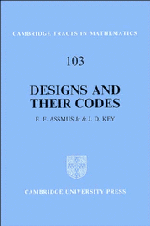2 - Codes
Published online by Cambridge University Press: 05 October 2015
Summary
Introduction
Error-correcting codes were introduced in the 1940s in order to implement a theorem of Shannon's [260] which guaranteed that virtually error-free communication could be obtained even over a noisy channel. The message to be communicated is first “encoded”, i.e. turned into a codeword, by adding "redundancy". The codeword is then sent through the channel and the received message is “decoded” by the receiver into a message resembling, as closely as possible, the original message. The degree of resemblance will depend on how good the code is in relation to the channel. The usual pictorial representation of this communication link is shown in the schematic diagram Figure 2.1.
Here a message is first given by the source to the encoder that turns the message into a codeword, i.e. a string of letters from some alphabet, chosen according to the code used; the encoded message is then sent through the channel, where it may be subjected to noise and hence altered; this possibly-altered message, when it arrives at the decoder belonging to the receiver, is, first of all, equated with the most likely codeword, i.e. the one (should that exist) that, in a probabilistic sense depending on the channel, was probably sent; finally this “most likely” codeword is decoded and the message is passed on to the receiver.
Example 2.1.1
Suppose we use an alphabet of just two symbols, 0 and 1, and we have only two messages, for example “no” corresponding to 0, and "yes” corresponding to 1. We wish to send the message “no”, and we add redundancy by simply repeating the message five times. Thus we encode the message as the codeword (00000). The channel interferes, perhaps, with the message and could, for example, change it to (01100). The decoder assesses the message and decides that of the two possible codewords, i.e. (00000) and (11111), the former is the more likely, and hence the message is decoded, correctly, as “no”.
Notice that we have made several assumptions here: for example we have assumed that the probability of an error at any position in the word is less than, that each codeword is equally likely to be sent, and that the receiver is aware of the code used.
- Type
- Chapter
- Information
- Designs and their Codes , pp. 25 - 88Publisher: Cambridge University PressPrint publication year: 1992



